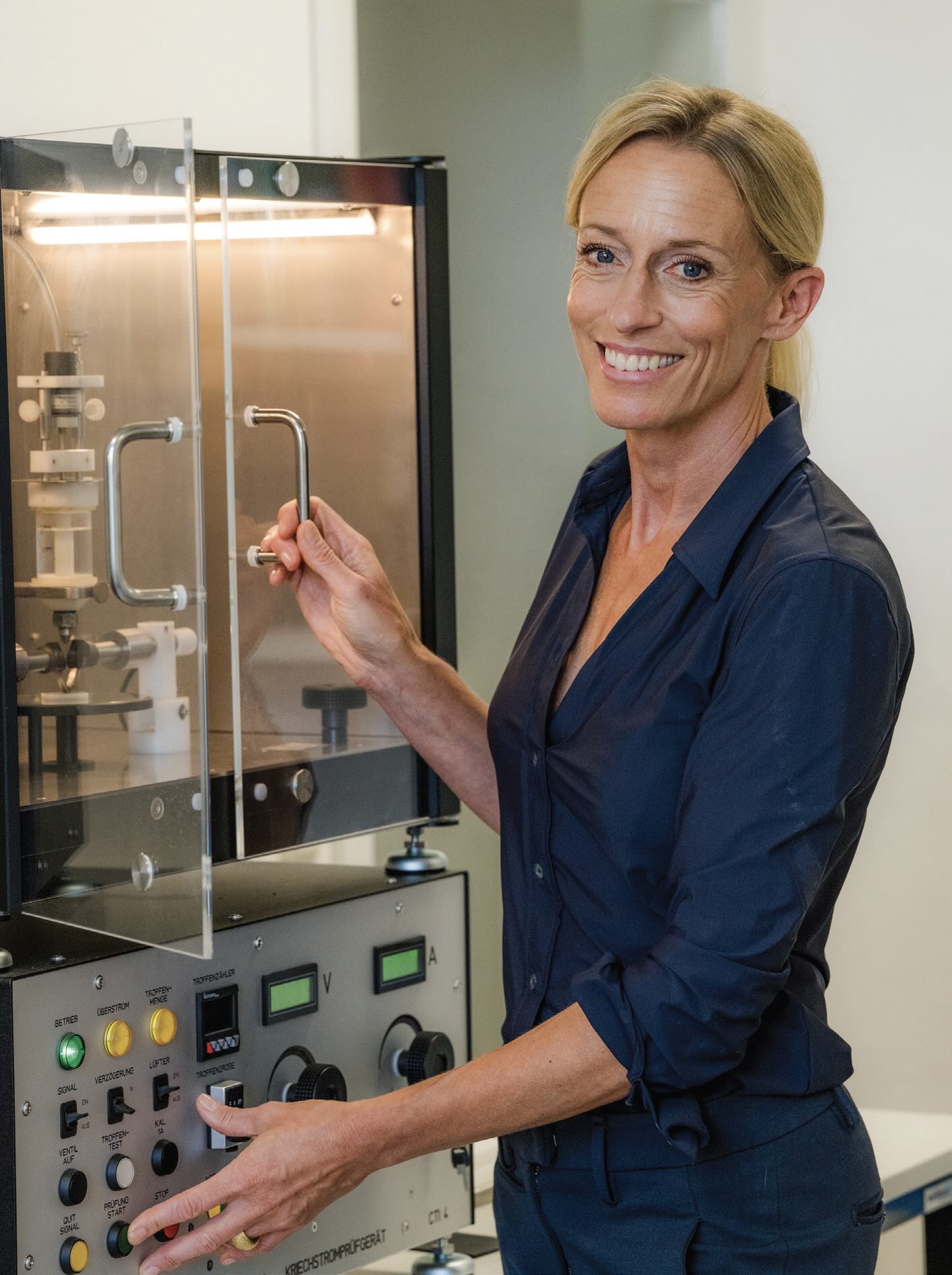20 Minutes With Annabelle Minz-Schütt
By Nicole Gleeson, Editorial Coordinator | TLT 20 Minutes February 2025
This managing director of Minz-Prüf + Test GmbH talks about independent lab testing and the oil and additives industries.
Annabelle Minz-Schütt - The Quick File
Annabelle Minz-Schütt is managing director of Minz-Prüf + Test GmbH, an accredited independent testing laboratory for plastics and elastomers.
After graduating as a mechanical engineer in the field of plastics technology at RWTH Aachen University in Aachen, Germany, in 1998, Minz-Schütt took over quality management at her father’s engineering company Minz. The initial accreditation of the laboratory according to ISO 17025 was successfully completed in 2003. After the company was renamed Minz Prüf + Test GmbH in 2004, she joined the management of the laboratory in 2008 alongside her father as managing director with sole power of representation. In 2016, the generation change took place with the handover of the laboratory from founder Reiner Minz to his daughter. In 2021, the spectrum of tests, which had previously been mainly mechanical and thermoanalytical, was expanded to include various test methods for determining a wide range of electrical properties.
With more than 45 years of experience in physical material testing under the influence of a wide range of environmental conditions, the laboratory also determines the media compatibility of these materials by determining mechanical, electrical and thermomechanical material properties as part of resistance tests.
In addition to resistance to heat and cold, ozone and various climates, determining media resistance is one of Minz-Schütt’s main areas of work.

Annabelle Minz-Schütt
TLT: How long have you worked in a lubrication-related field, and how did you decide to pursue a career in the lubricants industry?
Minz-Schütt: Actually, I’ve been working in this field since I was 14 years old. Back then, in German high school, I used to mill plastic test specimens from prefabricated parts and plates in my father’s laboratory on the weekends, which were then used for lubricant compatibility tests during the week. During vacations, I helped to prepare and measure the tests for our customers in the oil and additive industry and thus had the opportunity to observe the changes in the materials due to the influence of temperature and the surrounding media such as oils, greases and abrasives.
The different properties of the materials, depending on the storage parameters such as time and temperature and the environmental conditions in the form of various media such as air, oil, fuel, grease, etc., as well as the correlation between the various characteristic properties and the resulting consequences for the evaluation of compatibility, fascinated me and fostered my ever-growing motivation to learn more about it and to get to know the background. As the opportunities available at that time were significantly more limited compared to those of today, it made sense for me to follow in my father’s footsteps and study mechanical engineering at RWTH Aachen University, specializing in plastics technology.
TLT: What was the intention to found the first independent testing laboratory for plastics and elastomers in Germany in the context of lubricant testing?
Minz-Schütt: I actually have to pass this question on to my father. After a few years working as an engineer in materials development at a renowned car manufacturer in southern Germany, my father recognized the need for materials testing as an external service and set up his own independent materials testing laboratory for plastics and elastomers. His main motivation for setting up his own testing laboratory was to avoid long formal decision pathways in order to carry out his work as a materials specialist. The primary objective was to identify the best possible materials for respective areas of application.
The ability to react in a flexible and spontaneous manner to market requirements, not having to make compromises on equipment in order to achieve the most accurate and best possible results, and most of all, being in direct contact with experts among our customers was at the forefront of his decision to set up his own business.
TLT: What is the most rewarding aspect of your job?
Minz-Schütt: The versatility of lubricants with their additives, including their interactions with polymers, surprises me anew every day.
We meet growing challenges posed by the ever-increasing demands on the performance of materials and the surrounding media as well as their additives. We support the exciting ongoing and new developments required for this challenge, right up to novel biobased or recycled plastics and fluids.
The enriching transfer of knowledge that comes with exchanging experiences with experts from both industry sectors is one of the greatest advantages in our daily work.
Furthermore, our connections with both industries enable us to organize and source materials and media for the other industry, ensuring that requirements are met and practical resistance tests can be conducted effectively.
In addition to new, sustainable materials, I am frequently exposed to materials that I had limited experience with in the past, particularly in the context of developing oil-based immersion coolants for data centers. Today, the testing of insulation papers and liquid sealants or adhesives in conjunction with the corresponding media resistance tests is part of our daily testing routine. Our customers are faced with the challenge of providing suitable test specimens for testing at short notice in order to be able to drive forward their development work in a targeted manner due to global competition. I recognized the problem of this often laborious and time-consuming procurement process at an early stage and support our customers by taking over material procurement and specimen production wherever possible.

Annabelle Minz-Schütt in front of a tracking index device for determining the proof (PTI) and the comparative (CTI) tracking indices of solid insulating materials up to 600 volts.
TLT: What do you think is the next future challenge in lubricant compatibility testing?
Minz-Schütt: Definitely the compatibility with new sustainable materials or media and biobased materials, oils and fuels that are entering the plastics and sealing market, as well as the standardization of processes that map the influence of lubricants on application-specific electrical properties of the materials.
We are still at the beginning regarding compatibility with new materials like biobased or recycled plastics. The aim is to develop reproducible procedures that are limited to the actually relevant properties of lubricant-material compatibility, whereby artificial intelligence (AI) could possibly also play a role, particularly in the appropriate selection of procedures. Its integration into test planning will have an increasingly more important influence in the next few years.
TLT: What has been your most interesting project?
Minz-Schütt: Due to the versatility of our testing activities and our wide range of testing services, there is more than one project that comes to my mind.
What surprised me the most was the influence of test parameters in detail, such as the tightness of test vessels in the context of compatibility tests, which has been underestimated across all industries in the past. Of course, I am not referring to the obvious exclusion of oxygen, such as an autoclave and an open test vessel.
I remember back then—it was a matter of requalifying a commercially available transmission oil in conjunction with various elastomers. Our customer confronted us with a desolate out of range result from the elastomer manufacturer’s test laboratory compared to our still OK result. Both laboratories shared all test parameters, including the exchange of the test vessels, which at first glance appeared to be identical and supposedly airtight. Both glass vessels had a flat ground glass rim and were also tightly sealed with a plane-parallel ground glass lid and a clamp. The results remained unchanged even with the “competing vessels” on both sides. After a mutual visit for a detailed comparison of the procedure, the cause was quickly identified: while the external laboratory added additional grinding grease between the glass and the lid to seal it, we refused to add an additional medium and placed glass on glass. It was possible to rule out any influence on the result due to the ground-glass grease by adjusting with a comparable sealed system using a screw-top bottle with a polytetrafluoroethylene (PTFE) seal, but it was nevertheless recognized that supposedly sealed does not necessarily equal sealed and that a precise description of the test vessels is required for reproducible results across laboratories. This was achieved in 2022 with the revision of ISO 1817, the most common European standard for media resistance of elastomers and thermoplastic elastomers (current edition 2024-03), in which various test vessels and volume ratios are precisely described and assigned their own methods from A to E.
I also remember the establishment of one of our in-house methods in the field of dynamic mechanical analysis in various plant standards of suppliers and a well-known German automotive group. The background to this was the failure of a safety-relevant component at low temperatures after a change of supplier. Using conventional analysis methods to determine characteristic values at low temperatures, no difference was found between the “old” and the “new” material. All mechanical characteristics showed an excellent match. We used a wide range of testing options in finding the causal factors. For example, we prepared one specimen each from the historical and the new part from the retained samples and examined this using our in-house method with our dynamic mechanical analysis (DMA). The advantage here is that very small test specimens are sufficient for the DMA to obtain a quick overview of the actual mechanical-dynamic behavior of the material/finished part over a wide temperature range (in this case the entire application range, from -70°C to 60°C). It quickly became clear that although the cold temperature coefficient of the two materials matched, the material from the new supplier showed a significant increase in modulus from room temperature to lower temperatures due to the processing aids used in production, which led to a significantly different mechanical behavior at low temperatures and thus to failure. Our method was initially used as a standard test in our customer’s factory specifications and subsequently also in the requirements of a well-known German car manufacturer.
Today we also frequently use the method as part of media compatibility tests in order to be able to better assess the actual influence of the medium on the function of the finished parts in use. This not only helps to avoid failures and, in the worst case, product recalls, but also prevents unjustified disqualification of a medium due to non-relevant out of range properties of the material.
TLT: What is the No. 1 piece of advice you would give to a person who might be interested in starting a career in the lubricants industry?
Minz-Schütt: Be enthusiastic about what you do. It is so varied and exciting. There is always something new to discover. Keep your eyes open and look left and right, otherwise you might miss the important things. Keep up with the times and never stand still. Keep questioning your daily actions to optimize everyday processes and prevent them from becoming routine. See criticism as a chance to improve. And last but not least: Never assume you know everything, and always remain open to new ideas.
You can reach Annabelle Minz-Schütt at a.minz-schuett@minz-gmbh.de.